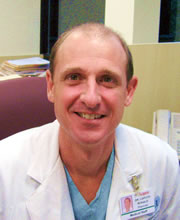
|
Q: You've been using the transradial approach (TRA) for interventional procedures since 1997. But something's been happening just in the past five years regarding TRA. When I talked about transradial five years ago, it was basically like I was doing an evangelical session trying to convince people it's the right thing to do. Now everywhere I go people are doing it and we're talking about tips and tricks. Docs have gone from talking about "how do you start a radial program" to "these are commonly encountered problems and here's how you deal with them." So it's really evolved. Q: How does this evolution changed adoption? There's always the need for clinical education, but what about the education of administration and institutional change?
Hospitals are now very motivated to make sure that outcomes are optimized. We're now looking at penalties for 30-day readmissions for acute MI diagnosis, pneumonia diagnosis, heart failure diagnosis. That's being expanded within the next couple of years to include PCI. Readmissions for PCI will not be reimbursed and, if you're higher than the national average on that, you're going to be economically penalized. So there's a lot of motivation at the institutional level to make sure you avoid unnecessary, and in fact, all readmissions possible. And vascular access complications are one of the reasons why people come back. If you go though the groin, there are quite often hematomas, bruising, re-bleeds. Those are concerns that basically go away when you adopt the transradial approach. From an institutional level they see that as an important driver. As we're moving towards outpatient PCI, that's also a big economic concern; we really are expected now to be doing a significant portion of our patients as outpatients. I think transradial offers some benefits in that regard. Hospitals are very motivated to see outpatient PCI expand and TRA is obviously a benefit to that. Some of the other economic advantages of TRA are in terms of patient turnover, decrease in patient's length of stay, inpatient or outpatient. So there's a lot of institutional motivation right now. The transradial committee at SCAI has put together the RAMP program for institutions that are interested in bringing TRA experts to their institutions to sort of motivate their operators to get going on TRA both from a nursing and ancillary staff perspective, as well as a physician standpoint. Q: Yes, SCAI has been very involved in supporting TRA in the U.S. Various device companies have also been sponsoring these types of activities, for example Medtronic has named June as "Transradial Awareness Month" and Terumo has been supporting training, etc.. Q: Talking about equipment, and the partnership with device companies, there really hasn't been the kind of profit motive we've seen with drug-eluting stents, for example, because the equipment for TRA consists of relatively small ticket nuts-and-bolts type items, like catheters, sheaths and pressure bands, etc. Number two, you know, it's really, I don't want to say corporate image, but there's definitely an aspect to that in my opinion. If a company is stepping up as a patient advocate and a physician advocate, it really buys them -- I'm not sure if the word is "good will" -- but certainly it's really good for the corporate image. It's a company that you will want to partner with, that you will respect. And they'll be there not only in the commercial aspect of the field, but also advancing patient care in the field. And the last point, you are selling stents and some other relatively high-margin items, that's why you're in the field. You're selling these things, and if you're there, working in tandem with physicians and institutions in bringing value-added projects like transradial to the forefront, it's a good opportunity to showcase the stuff you want to get a commercial advantage on. So I think there's a lot of reasons why this partnership is important. And Terumo and Medtronic are kind of on the forefront. I know that Abbott and Boston are coming along but I think there's a lot of reasons for these big companies to help with transradial. Q: What's involved in getting a radial program into your hospital, from physician-training to staff training. For example, even in the CCU it's important to train staff regarding the best way to do pressure dressing.
So you want to do a workshop. And then you want to bring somebody into your lab or visit a lab that does a lot of TRA. You need a site visit or you need somebody to come in and look at your site. So it's a two-step process. Maybe even down the road. People will kind of dive in and get all enthusiastic about TRA, but the learning curve is long. Christian Spaulding did a study back in the late 90's and he showed that it really takes 200-300 cases for an operator to really get proficient at TRA. So there's always a hump after about 50 or 70 cases where people kind of lose interest. They need a little energizing. They need to remember why they're doing it. You do those first few cases, you're enthusiastic. But they get harder, you get a little fatigued, you might have a complication or two. So after you done 6 months, 9 months, it might be helpful to have another site visit or have somebody come in or get re-energized at that point. So something didactic, maybe the SCAI transradial meeting or whatever, and then a site visit or you visit someone and then after 6-9 months, maybe a booster. Get everybody involved. It's a team approach. You can do it through a company, you can do it through SCAI, but if you get multiple people motivated it's always easier. You reach a critical mass. Q: There's been a lot of studies out recently about the specific advantages of transradial in the setting of ST-Elevated Myocardial Infarction (STEMI).
|



